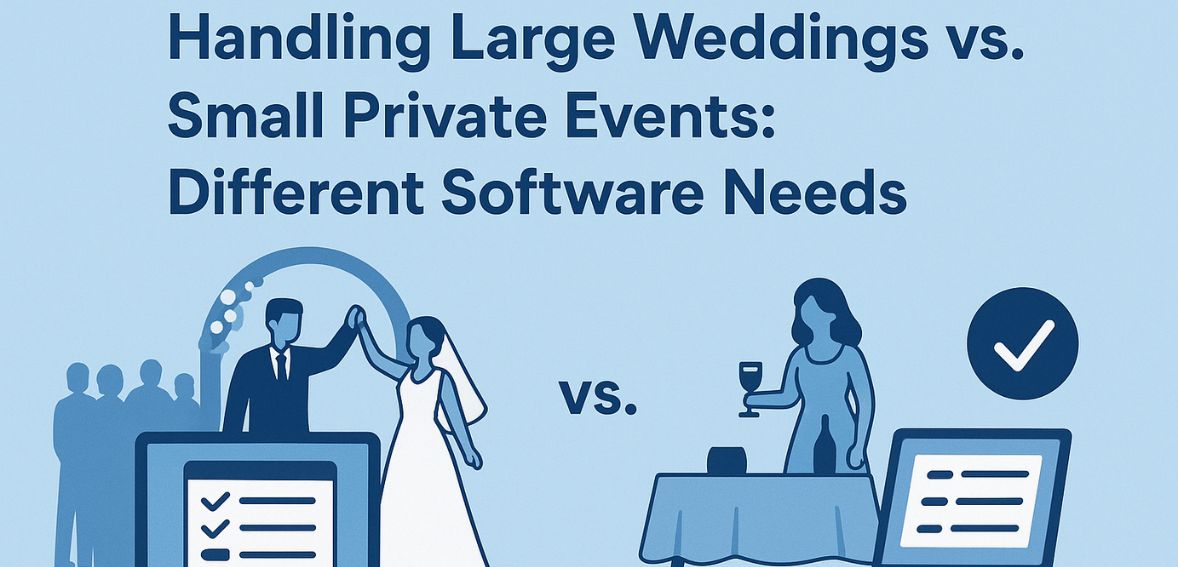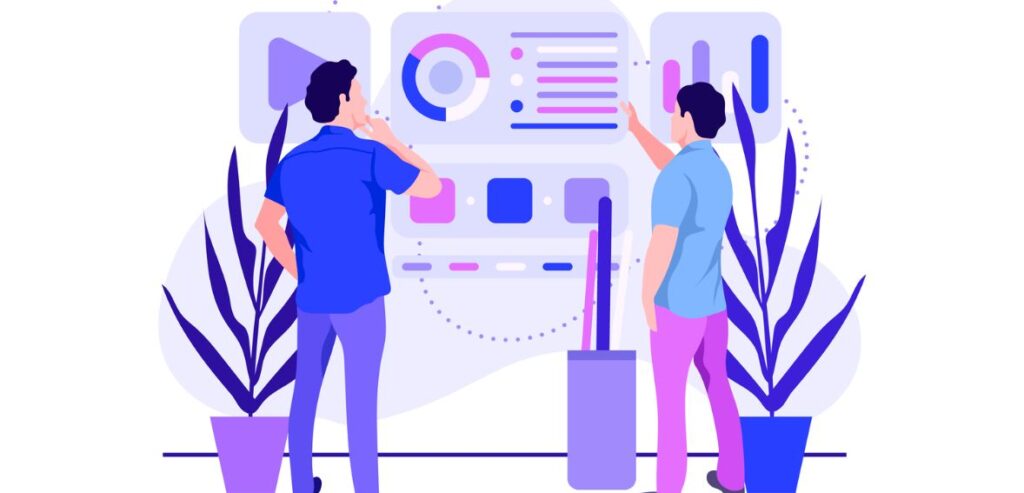
By cloudcateringmanager September 1, 2025
Emotions are just as much a part of event planning as logistics. A small private gathering thrives on intimacy, warmth, and personal touches, whereas a large wedding with hundreds of guests, live entertainment, and numerous vendors carries a sense of grandeur that requires careful coordination.
However, an invisible framework for preparation—event management software needs—often determines whether the celebration, music, and laughter are successful. With the correct tools, stressful tasks can be executed with ease, and overwhelming checklists can be transformed into well-organized workflows.
What is ideal for a large wedding might seem unnecessary for a small dinner party. The key to ensuring that every detail, no matter how small, is executed flawlessly is to match software needs to the event scale. This article explores the differences in software requirements between big weddings and intimate parties, providing guidance on selecting the best option for each.
Why Software Matters in Event Planning

Precision, timing, and clear communication have always been key components of event planning, but with today’s expectations higher than ever, software has emerged as the key to success. Whether organizing a wedding or hosting a private event, couples expect perfect coordination, real-time updates, and seamless guest experiences.
By bridging the communication between planners, vendors, and clients, software makes sure that no information is overlooked and that no budget goes off from the original plan. Automating routine processes like budget tracking, vendor confirmations, and guest check-ins also helps lower human error. Even the best planner can become stressed by spreadsheets, emails, and last-minute changes if they don’t have the proper tools.
Technology is more than just a convenience in today’s workplace; it is essential. With today’s expectations higher than ever, software has emerged as the key to success. Whether organizing a wedding or hosting a private event, it’s important to explore different event management software options to ensure seamless coordination, real-time updates, and smooth guest experiences.
The Growing Role of Technology in Guest Experience
From the time they receive an invitation to the final toast of the evening, guests have grown increasingly tech-savvy and expect seamless digital experiences. Software tools enable smooth RSVP management, seating charts, and even mobile apps that help guests navigate multi-day itineraries for large weddings.
Simpler platforms that manage RSVPs and reminders without complicating the planning process are frequently used by hosts for smaller events. By clearing up misunderstandings and enhancing communication, the appropriate software improves the visitor experience in both situations.
Beyond the actual event, a lasting impression is created when guests feel appreciated and informed. One of the main factors influencing how crucial it is to choose the appropriate platform is the rising demand for digital convenience.
Software Needs for Managing the Complexity of Large Weddings

A big wedding is frequently compared to planning a theatrical production. Even the slightest delay can cause major disruptions because there are dozens of moving parts, countless people involved, and a strict schedule. Several hundred people can readily be added to guest lists, many of whom may have special dietary requirements, travel requirements, or lodging preferences.
It is practically impossible to coordinate such logistics without complex software. Tools with multi-user access are frequently needed for large weddings so that vendors, planners, and occasionally even the couple can monitor progress and work together in real time. It becomes crucial to have software features like interactive seating charts, vendor management systems, budget trackers, and centralized communication portals.
These functions guarantee that everyone is aware of the same information and can react quickly to any changes. To minimize misunderstandings, the software should automatically sync headcounts with seating and meal preference lists, for example, if a catering vendor needs to update them. Another important consideration for big weddings is scalability.
The program needs to be able to manage many different tasks at once without becoming slow. Contracts, invoices, design proposals, floor plans, and deadlines are frequently all juggled simultaneously by planners. These tasks are consolidated by advanced platforms made for big events, which allow planners to delve into the smallest detail while still having a broad overview of the wedding.
The Simplicity of Small Private Events
On the other hand, intimacy is typically more important at a small private event than size. Whether it’s a milestone birthday, a family reunion, or a private engagement party, the emphasis is on human connection rather than intricate planning.
Although the level of complexity is much lower, it does not imply that planning is simple—invitations are still required, seating arrangements may still be necessary, and food preferences are still important. Software that prioritizes usability over a wealth of features is frequently advantageous for planners of these kinds of events.
It might be enough to have an app that enables digital invitations, RSVP tracking, and fast guest list management. Rather than making the process simpler, adding extra layers such as advanced vendor dashboards or extensive budget allocation tools can make it more complicated.
Maintaining clarity, avoiding overcomplication, and streamlining communication between the planner and the host are the objectives when it comes to small events. Software should be simple and easy to use because small private events are usually run by a single planner or even the host. Complex platforms created for large-scale events are frequently less valuable than tools with mobile-friendly interfaces, customizable invitation templates, and drag-and-drop design capabilities.
Budgeting and Financial Management

Financial management is one of the most obvious distinctions between big weddings and intimate gatherings. Catering, décor, attire, photography, entertainment, rentals, and transportation are just a few of the many areas where large weddings frequently involve substantial financial outlays. Contract tracking, staged payments, and deposits might be necessary for each category.
Event planners can keep tabs on these expenses, remind attendees of impending payments, and make sure the event stays within budgetary constraints with the aid of an extensive budgeting tool built into the software. In contrast, small private events typically have a much smaller budget and fewer vendors.
Here, the software requirements are simpler: it must be able to track a small number of expenses, generate invoices quickly, and handle payments effectively. While advanced financial dashboards may be included in large-scale wedding software, spreadsheets, or simple budgeting is more common among private event planners.
Guest Experience and Communication
Large weddings and small private events both revolve around the guest experience, but they are handled very differently. Guests at large weddings frequently travel from different places, so they may need hotel rooms, transportation, and customized itineraries for celebrations that last several days.
Event management software with integrated communication features is extremely helpful in these situations. Digital guides, travel updates, and automated reminders keep everyone informed without hitting the planner with individual messages. Guest communications are typically more intimate for small gatherings.
Personalized notes, personalized invitations, or direct text updates may be preferred by hosts over automated mass messages. These needs are better served by software that offers flexible communication options, like RSVP tracking or simple email integration, than by large-scale platforms.
Vendor Coordination

Another area where scale is important is in vendor management. Dozens of vendors, each with their own contracts, specifications, and timetables, may be involved in a big wedding. On the big day, the coordination of a florist, caterer, DJ, photographer, rental company, and transportation service must be flawless.
To keep everything organized, vendor portals, shared calendars, and integrated contract management tools are frequently included in event management software and event catering software made for big weddings.
Only a caterer and possibly a decorator or photographer may be on the list of vendors for smaller events. The host might only need software that saves contact information, payment dates, and task reminders rather than advanced dashboards. For this degree of planning, portable tools or even smartphone apps might be ideal.
Customization and Creativity
Regardless of the size of the event, creativity is essential to its planning. Software that lets planners make and see mood boards, digital design previews, and seating arrangements is especially helpful for weddings. Couples collaborate more easily and make decisions more quickly when they can view a digital mock-up of their reception design or floral arrangements.
Customization is typically more about adding personal touches than elaborate designs for smaller events. Software that provides customizable menus, photo-sharing capabilities, or basic invitation templates might be more suited to the host’s requirements. Lightweight tools still offer ways to add meaningful and unique touches, even though large wedding software might be too much for such projects.
Scalability and User Access
Another difference is in scalability. Large weddings often require a software solution that multiple people can access simultaneously. Planners may delegate tasks to assistants, vendors, or even family members of the couple. Having a platform that allows role-based access ensures everyone is updated in real time without compromising sensitive information.
Small private events rarely require this level of collaboration. Typically, one or two people manage the entire process. In such cases, overly complex access settings may be unnecessary, and a single-user platform works better.
Technology and Integration

Software that interfaces with other systems is also beneficial for large events. For instance, seamless coordination between various planning components is ensured by integration with payment gateways, email marketing tools, and customer relationship management systems.
When handling hundreds of visitors and numerous service providers, this degree of integration makes sense. Integration is less important for minor events. In general, simpler platforms that organize everything are more useful. Reducing complexity is more important than adding more tools that come with learning curves or additional expenses.
Emotional and Human Elements
Beyond the practical aspects, it’s critical to keep in mind that both big weddings and small gatherings are intensely emotional events. This emotional experience should be supported by software, not surpassed by it.
The ability to customize the journey for the couple and their guests must be balanced with functionality in large-scale wedding software. The software should be more of an assistant than a business system for smaller events so that hosts can concentrate on having fun without getting lost in unnecessary features.
Conclusion
Creating meaningful, unforgettable experiences for all those involved is the common goal of both large weddings and small private events. However, they have quite different software requirements. While small private events thrive on clarity, simplicity, and personalization, large weddings require strong platforms that manage scale, complexity, and collaboration.
Planners and hosts who wish to optimize efficiency without sacrificing the human element that makes events unique must be aware of these distinctions. The software that best suits the size and tone of the event, not the one with the most features, is ultimately the best.
Whether it is a grand ballroom wedding or an intimate dinner party, choosing the right platform ensures that technology becomes a seamless partner in the process rather than a hurdle to overcome. By aligning software choices with event size and style, planners and hosts can focus on what truly matters—bringing people together to celebrate life’s most important moments.